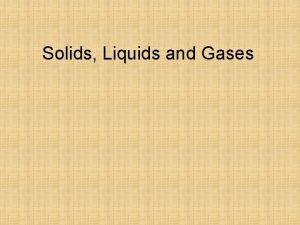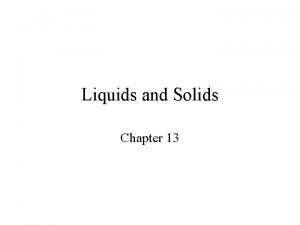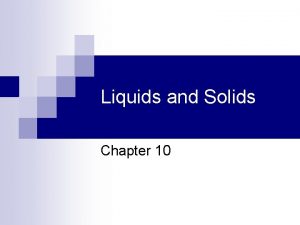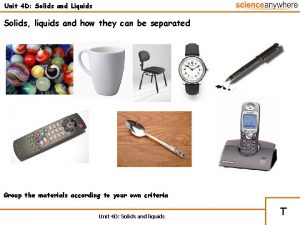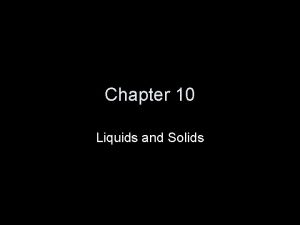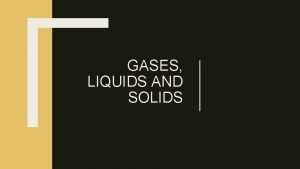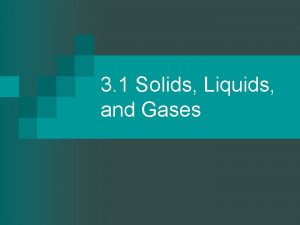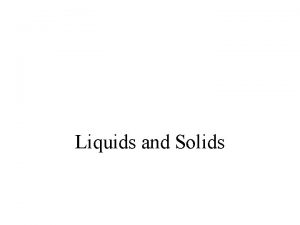Densities of Liquids and Solids Density Density is










- Slides: 10

Densities of Liquids and Solids

Density ØDensity is the ratio of the mass of a substance to its volume. ØIn this experiment, we will determine the density of liquids and solids. The density of a substance can be used to identify a liquid or solid Øbecause density is an intensive property. ØIntensive properties : are properties that do not depend on the quantity of the substance. For example, gold, which is relatively dense, can be separated from sand, silt, and rock by panning for it in a stream because of its greater density.

q The units of density are normally expressed as g/m. L or g/cm 3. (A m. L and a cm 3 are different expressions of the same unit, (1 m. L = 1 cm 3).

Density of liquid q The density of a liquid can be determined by weighing a known volume of the liquid. q To determine the density of a sodium chloride solution, first, weigh a clean, dry 10 -m. L graduated cylinder. Next, sodium chloride solution is added to the graduated cylinder and it is reweighed. The volume of sodium chloride solution in the graduated cylinder is recorded by reading the level of liquid in the cylinder at the bottom of the meniscus.

Figure 1 Weighing an empty 10. 0 m. L graduated cylinder. Figure 2 Weighing a 10. 0 m. L graduated cylinder containing sodium chloride solution. q Knowing the mass (42. 639 g - 37. 198 g = 5. 441 g) and volume of the sodium chloride solution (5. 13 m. L) in the graduated cylinder. q The density of the solution is calculated to be (5. 441 g / 5. 13 m. L = 1. 06 g/m. L).

Density of regular solid Ø Solids can be regularly shaped (cylindrical, cubical, spherical, etc. ) or irregularly shaped (metal turnings or shot). An object’s shape determines which of the following two methods is used to determine its volume. The dimensions of a regularly shaped object can be measured with a ruler and the volume calculated using the appropriate geometric equation. Ø A cylindrical rod of aluminum metal with its length and radius is depicted In (Figure 3).

The metal’s volume can be calculated by measuring its length (L) and its radius (r) using the geometric relationship for the volume of a cylinder, V = πr 2 L, where V is volume and π is 3. 1416. If the aluminum rod has a mass of 29. 7 g, the density of aluminum can be calculated to be 2. 7 g/cm 3.

Ø It can be difficult to measure the radius of a sphere. The radius of a sphere is related to its circumference by the following formula. Knowing the circumference of the sphere, its radius can be calculated. Ø (circumference = 2 π r) Ø Irregularly shaped solids cannot easily be measured with a ruler. Instead, their volume is most easily determined by the displacement of water or some other liquid.

Density of irregular solid The solid (which must not react with the liquid and have a density greater than the liquid) is placed in a calibrated container (usually a graduated cylinder) containing measured volume of the liquid. The solid will displace an amount of liquid equal to its volume. The difference in the liquid’s volume in the cylinder before and after the object is added is equal to the volume of the irregularly shaped object.

100 m. L graduated cylinder with the smallest calibration unit of 1 m. L: a) volume of water is 16. 3 m. L; b) Meniscus indicates 18. 7 m. L after the addition of 20. 837 grams of copper shot. q Therefore, the volume of the copper shot is (18. 7 -16. 3 = 2. 4 m. L). q From this data, the density of copper is determined to be (20. 837/2. 4 = 8. 7 g/m. L).
 Expansion of solids liquids and gases examples
Expansion of solids liquids and gases examples Buoyancyability
Buoyancyability Kinetic molecular theory of liquids and solids
Kinetic molecular theory of liquids and solids Solid
Solid Venn diagram of 3 states of matter
Venn diagram of 3 states of matter Properties of a solid
Properties of a solid Process of liquid to gas
Process of liquid to gas Adhesive force
Adhesive force Liquids and solids menu
Liquids and solids menu Lesson 1 thermal energy and the behavior of matter
Lesson 1 thermal energy and the behavior of matter Chapter 14 solids liquids and gases worksheet answers
Chapter 14 solids liquids and gases worksheet answers











